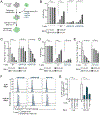Pharmacologic Screening Identifies Metabolic Vulnerabilities of CD8+ T Cells
- PMID: 33277233
- PMCID: PMC7864883
- DOI: 10.1158/2326-6066.CIR-20-0384
Pharmacologic Screening Identifies Metabolic Vulnerabilities of CD8+ T Cells
Abstract
Metabolic constraints in the tumor microenvironment constitute a barrier to effective antitumor immunity and similarities in the metabolic properties of T cells and cancer cells impede the specific therapeutic targeting of metabolism in either population. To identify distinct metabolic vulnerabilities of CD8+ T cells and cancer cells, we developed a high-throughput in vitro pharmacologic screening platform and used it to measure the cell type-specific sensitivities of activated CD8+ T cells and B16 melanoma cells to a wide array of metabolic perturbations during antigen-specific killing of cancer cells by CD8+ T cells. We illustrated the applicability of this screening platform by showing that CD8+ T cells were more sensitive to ferroptosis induction by inhibitors of glutathione peroxidase 4 (GPX4) than B16 and MC38 cancer cells. Overexpression of ferroptosis suppressor protein 1 (FSP1) or cytosolic GPX4 yielded ferroptosis-resistant CD8+ T cells without compromising their function, while genetic deletion of the ferroptosis sensitivity-promoting enzyme acyl-CoA synthetase long-chain family member 4 (ACSL4) protected CD8+ T cells from ferroptosis but impaired antitumor CD8+ T-cell responses. Our screen also revealed high T cell-specific vulnerabilities for compounds targeting NAD+ metabolism or autophagy and endoplasmic reticulum (ER) stress pathways. We focused the current screening effort on metabolic agents. However, this in vitro screening platform may also be valuable for rapid testing of other types of compounds to identify regulators of antitumor CD8+ T-cell function and potential therapeutic targets.
©2020 American Association for Cancer Research.
Figures







References
Publication types
MeSH terms
Substances
Grants and funding
LinkOut - more resources
Full Text Sources
Research Materials

